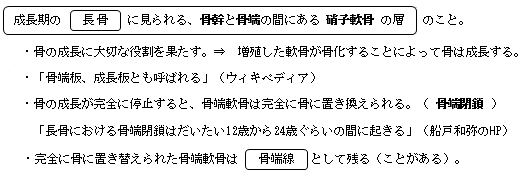骨端軟骨とは


「船戸和弥のホームページ」では以下のような解説が見られる。
「長骨の長さの成長は、骨自身が成長するのではなく、土台になる軟骨が成長し、これが、骨に置きかわることによって行われる。軟骨の成長は骨端と骨幹の境の増殖帯でおこる。すなわち、この部分で軟骨細胞が長軸方向に活発に分裂することによって軟骨の長さが伸びる。一方、骨幹の側で軟骨は変性、除去され、骨組織で置換されていく。同様の骨による置換は骨端部でも後になっておこる。こうして骨端と骨幹の境に骨端軟骨と呼ばれる軟骨の層が形成される。軟骨の成長よりも、破壊の方が早く進めば、骨端軟骨は薄くなる。骨端軟骨が完全に置き換えられると(骨端閉鎖)、骨の成長は止まる。X線像で骨端線として見えるのは、閉鎖した骨端軟骨である。長骨における骨端閉鎖はだいたい12歳から24歳ぐらいの間におこる。 」
以下は「Wikipedia」の解説文となる。
「The epiphyseal plate (or epiphysial plate, physis, or growth plate) is a hyaline cartilage plate in the metaphysis at each end of a long bone.
The plate is found in children and adolescents; in adults, who have stopped growing, the plate is replaced by an epiphyseal line.
Development
Endochondral ossification is responsible for the initial bone development from cartilage in utero and infants and the longitudinal growth of long bones in the epiphyseal plate. The plate's chondrocytes are under constant division by mitosis. These daughter cells stack facing the epiphysis while the older cells are pushed towards the diaphysis. As the older chondrocytes degenerate, osteoblasts ossify the remains to form new bone. In puberty increasing levels of estrogen, in both females and males, leads to increased apoptosis of chondrocytes in the epiphyseal plate.[1] Depletion of chondrocytes due to apoptosis leads to less ossification and growth slows down and later stops when the entire cartilage have become replaced by bone, leaving only a thin epiphyseal scar which later disappears.[2]」
【参考にしたサイト】
・イラストや写真を掲載しているサイト-Ⅰ
・イラストや写真を掲載しているサイト-Ⅱ
・イラストや写真を掲載しているサイト-Ⅲ
・イラストや写真を掲載しているサイト-Ⅳ
・レントゲン画像を掲載しているサイト(脛骨・腓骨の骨端軟骨がよく確認できる)
